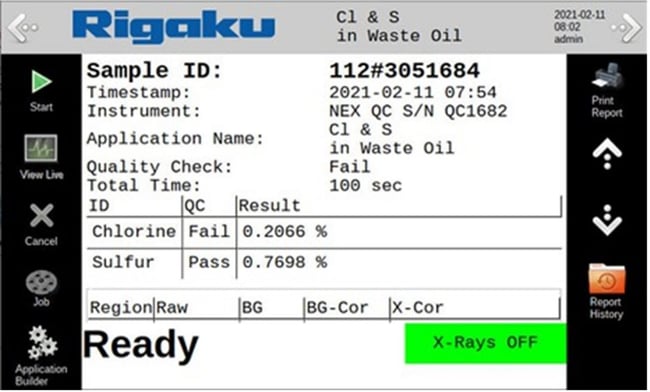Cl and S in Waste Oil and Used Oil

Scope
The analysis of chlorine and sulfur in oil is demonstrated as it relates to waste oil and used oil.
Background
Waste oil is the generic term for oil that has been contaminated. Used oil is the U.S. EPA designation for any petroleum or synthetic oil that has been used and become contaminated by physical or chemical properties. In both cases the oil is considered hazardous waste if the total chlorine level exceeds regulatory limits. Excessive chlorine in oil products can lead to corrosion during use or cause hazardous wastes and gases when burned. Therefore, it is important to measure the chlorine content in used and waste oils during collection, recycling and disposal to meet environmental norms when recycled into new products, used as alternative fuel, or for proper and safe disposal. Rigaku offers the NEX QC Series of EDXRF analyzers for the fast and simple measurement of chlorine and sulfur in oil for compliance with EPA and international environmental norms.
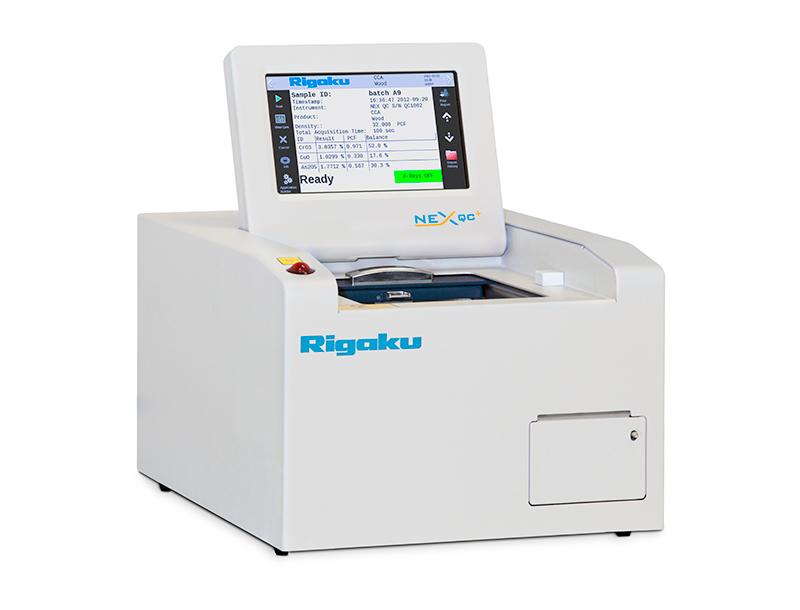 Model: NEX QC+
Model: NEX QC+
Calibration
A commercially available set of certified standards in mineral oil was used for calibration, with typical results demonstrated here.
| Element: Cl Units: % |
||
| Sample I.D. | Standard value | Calculated value |
| 2 | 0.600 | 0.5940 |
| 3 | 0.025 | 0.0230 |
| 4 | 0.200 | 0.2060 |
| 5 | 0.803 | 0.8050 |
| 6 | 1.004 | 1.0040 |
| 7 | 0.101 | 0.0950 |
| 8 | 0.010 | 0.0080 |
| 9 | 0.403 | 0.4050 |
| 10 | 0.050 | 0.0550 |
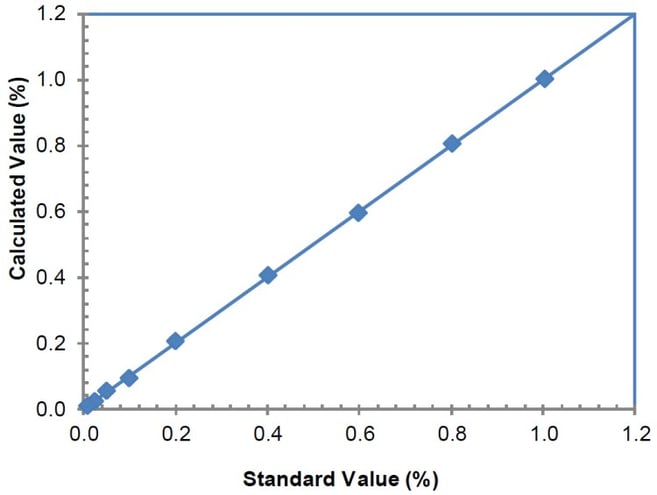 Correlation plot Cl
Correlation plot Cl
| Element: S Units: % |
||
| Sample I.D. | Standard value | Calculated value |
| 2 | 0.250 | 0.2610 |
| 3 | 1.000 | 0.9970 |
| 4 | 0.750 | 0.7620 |
| 5 | 0.100 | 0.1060 |
| 6 | 2.500 | 2.4970 |
| 7 | 0.020 | 0.0140 |
| 8 | 1.500 | 1.4800 |
| 9 | 0.050 | 0.0440 |
| 10 | 2.000 | 2.0140 |
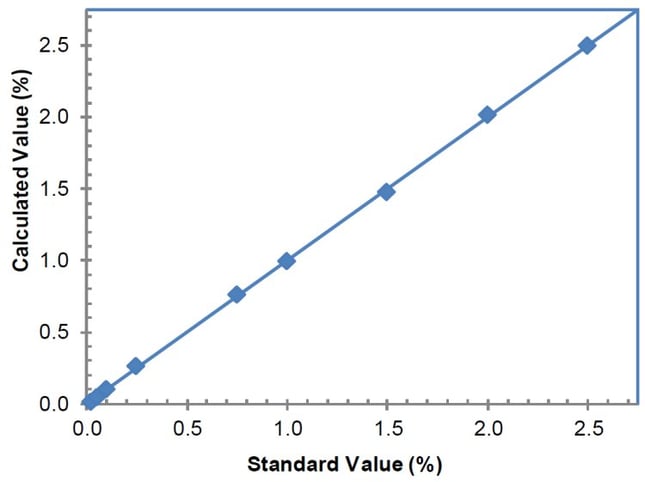 Correlation plot S
Correlation plot S
Repeatability
To demonstrate repeatability, samples were measured in static position for ten repeat analyses.
| Sample: Std 7 Units: % |
||||
| Element | Standard value | Average value | Std. dev | % Relative dev |
| Cl | 0.101 | 0.097 | 0.0002 | 0.2% |
| S | 0.020 | 0.018 | 0.0003 | 1.5% |
| Sample: Std 8 Units: % |
||||
| Element | Standard value | Average value | Std. dev | % Relative dev |
| Cl | 0.010 | 0.009 | 0.0001 | 1.0% |
| S | 1.500 | 1.509 | 0.006 | 0.4% |
| Sample: Std 6 Units: % |
||||
| Element | Standard value | Average value | Std. dev | % Relative dev |
| Cl | 1.004 | 1.008 | 0.003 | 0.3 |
| S | 2.500 | 2.508 | 0.007 | 0.3 |
U.S. EPA
The U.S. EPA regulates chlorine in used oil greater than 1000 ppm as hazardous waste and must be processed or disposed of properly under hazardous waste guidelines. Used oil with less than 1000 ppm Cl is considered non-hazardous and can be recycled or burned safely.
EPA Method 9075, Test Method for Total Chlorine in New and Used Petroleum Products by Energy Dispersive X-ray Fluorescence Spectrometry (XRF), describes the measurement of chlorine and sulfur in petroleum oil. Sulfur is measured for correction of chlorine results for X-ray absorption matrix effects. Calibration is described using mineral oil standards, and the method gives repeatability required of the analyzer and reproducibility among several operators, several analyzers and multiple testing facilities.
Repeatability is the 95% confidence precision of the measurement by one operator measuring repeat analyses of one sample on one analyzer over a short period of time. Repeatability is 2.77 times the standard deviation of the repeats and a single measurement result may exceed the repeatability precision only one in twenty measurements.
NEX QC+ easily meets the repeatability requirements to be used in compliance with EPA Method 9075.
|
U.S. EPA Method 9075 |
||||
|
Cl concentration |
NEX QC+ Std. Dev (σ) |
NEX QC+ 2.77σ |
EPA 9075 |
Compliance |
|
1000 |
2 |
6 |
181 |
PASS |
|
100 |
1 |
3 |
57 |
PASS |
Validation pass/fail reporting
NEX QC+ touchscreen software includes several validation schemes with limits set by the user. In this example the 'Pass Below' scheme is chosen with the max limit of 0.1000% set for Cl.
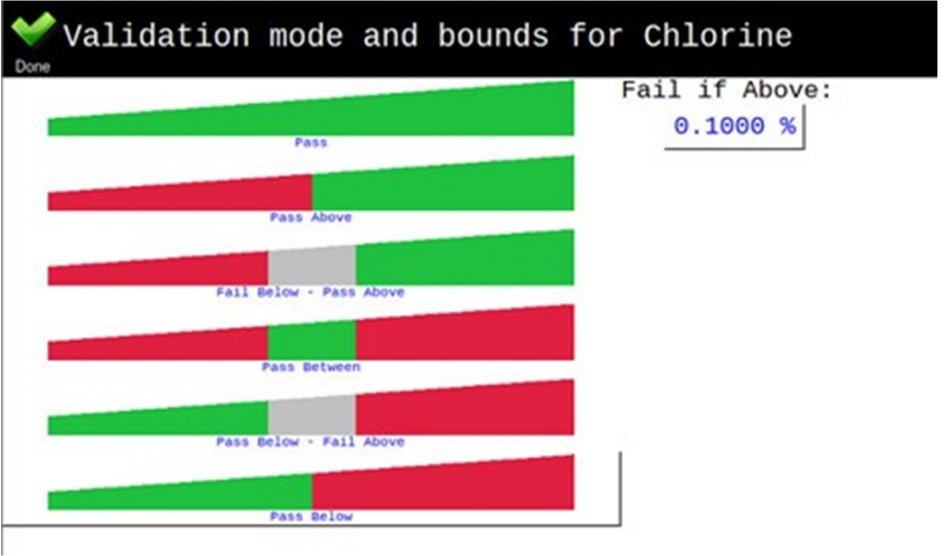 The Pass/Fail judgement is shown in the result report for the measurement, giving the operator a judgement confirmation and record of the results and judgement when logging results to spreadsheet or PDF.
The Pass/Fail judgement is shown in the result report for the measurement, giving the operator a judgement confirmation and record of the results and judgement when logging results to spreadsheet or PDF.
Conclusion
The performance shown here demonstrates the ability of the NEX QC+ for the fast and simple measurement of chlorine and sulfur in waste oil and used oil to meet EPA environmental norms. The simple user interface and low maintenance robust design of the NEX QC+ allows operators of all skill levels to use and maintain the equipment.

Contact Us
Whether you're interested in getting a quote, want a demo, need technical support, or simply have a question, we're here to help.

